Among the few ancient bridges with the “upper house, lower bridge” architecture that still exist in Vietnam, Nam Dinh (Ninh Binh) is a rare place that still preserves three covered bridges. These are Lang Kenh covered bridge (Truc Ninh 1 commune), Cho Thuong covered bridge (Nam Truc 4 commune), and Cho Luong covered bridge (Hai Anh commune).
All three of these famous bridges are hundreds of years old. Despite the vicissitudes of time, the covered bridges still retain their unique shapes, becoming cultural symbols, the pride of the local people and also an unmissable destination for tourists from afar.
Among them, Luong Market Covered Bridge stands out with its ancient, rustic but also very sophisticated beauty, considered one of the three most ancient and beautiful covered bridges in Vietnam, ranked by the State as a Historical Monument in 1990.
Ancient, rustic beauty intact after more than half a century
The ancient bridge is located about 100m from Luong Pagoda and is located right on the road leading to the pagoda, attached to the pagoda to form a cluster of relics. Therefore, local people often call the bridge by the name of Luong Pagoda Tile Bridge. At the same time, because it is located near the bustling Luong market, the bridge also has another more popular name, Luong Market Tile Bridge.
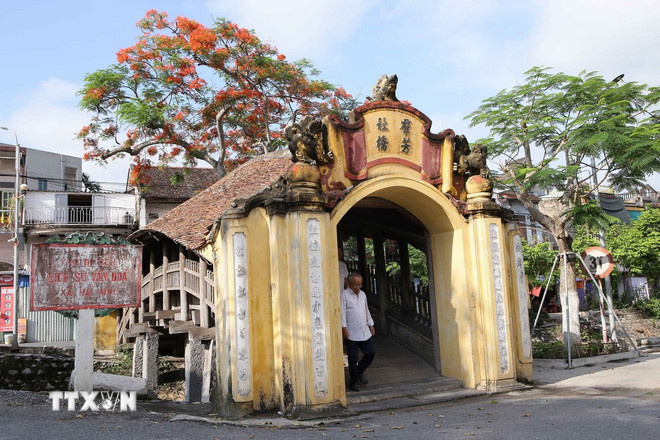
Since its inception, the bridge has not only been a way to cross the river, but also a place for villagers to stop, chat, and rest after going to the market, going to the pagoda, or returning from the fields. The bridge is both a traffic structure and a community living space - a beautiful feature of ancient village architecture.
According to ancient documents, Luong market covered bridge was built at the same time as Luong pagoda around the 16th century. The bridge spans Trung Giang river, a small river running along Hai Anh commune.
After more than 500 years of existence, the Luong Market covered bridge is still preserved quite intact with ancient and unique architectural features typical of the 17th-18th century, clearly demonstrating the talent of the craftsmen of the ancient Son Nam Ha town.
"Treasure" of pure Vietnamese architecture
The bridge was built in the style of "house above, bridge below". At first, the bridge did not have a tiled roof, only a simple grass roof. In the 17th century, the bridge was restored and repaired to match the scale and general landscape of the Luong Pagoda complex. In particular, the major restoration in 1922 gave the bridge the majestic appearance it has today.
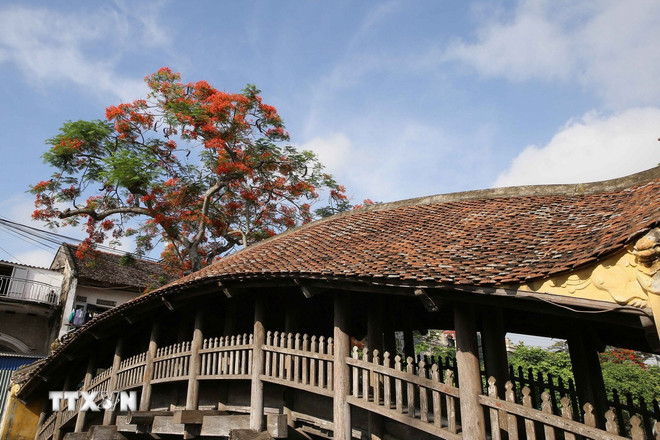
From afar, the bridge looks like a long tiled house lying across a small river. Above is a softly curved tiled roof, below is a sturdy ironwood bridge body. The system of stone pillars, wooden pillars, rafters and beams are arranged tightly, connected by traditional wooden joints, making the whole structure both sturdy and flexible.
The bridge is firmly built on 18 square stone pillars, each side 35cm, arranged in 6 neat rows, supporting 6 trusses, supporting the entire 9 compartments of the bridge. On those solid stone pillars is a system of large ironwood crossbeams and longitudinal beams, both durable and majestic, supporting the wooden beams, raising the bridge floor and the tiled-roof house above.
The bridge floor is divided into two parts. The bridge bed is a 2m wide walkway, paved with tightly fitted ironwood planks, lying on curved beams. In particular, the shorter planks have rounded edges, creating raised edges to prevent people from slipping.
On both sides of the bridge are two rows of high corridors made of wooden planks curved to the shape of the bridge, forming a long row of benches connecting from one end of the bridge to the other. Outside, there are railings with upper and lower railings, and waves… both sturdy and graceful.
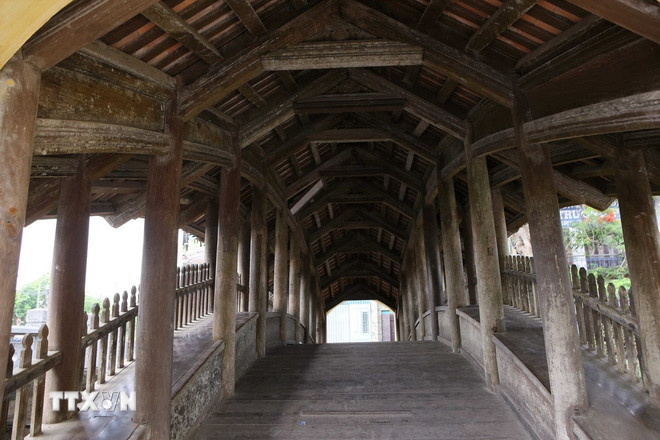
People and pedestrians can sit on this corridor-bench and leisurely enjoy the view of the river and peaceful countryside.
To build a 9-span tile-roofed bridge, the ancients had to use 10 sets of trusses with a system of beams and columns in traditional architectural style, of which 40 main columns and secondary columns were the main components.
The trusses, 36 longitudinal beams, upper beams, cross beams, upper and lower beams, and the rafters are all meticulously crafted, with precision down to each wooden mortise and tenon, making the entire bridge frame both sturdy and flexible, curving like a masterpiece of carving in space.
The bridge roof is skillfully tiled, each tile fits together and is not misaligned. The talented craftsmen of the past created a solution of “half roofing, half construction” to make the bridge roof curve gracefully like a flying dragon.
Although the wooden part of the Luong Market covered bridge is not elaborately carved, just with rows of grooves, lines on the rafters, the levers, rows of beams, and panels shaped like butterflies, the ends of the bars shaped like Bodhi leaves, it still shows the talent of the traditional Vietnamese carpentry of Quan Anh land, especially through the arrangement of the columns, the rafters' structures and the way of joining wooden mortises...
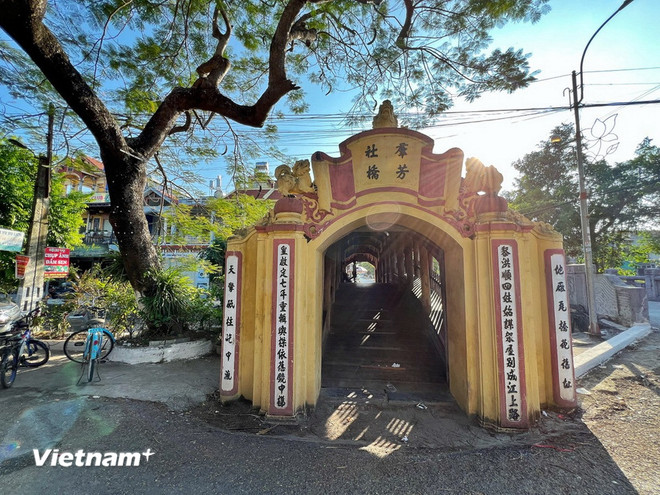
The masonry is also quite special, especially the two bridge gates built in the style of arches, flanked by rows of columns with Chinese parallel sentences. On the gate arches are two majestic chimeras holding a scroll engraved with the four words “Quan Phuong Xa Kieu,” meaning the bridge of Quan Phuong commune.
Both familiar and solemn, the bridge gate is like a bridge leading visitors into an ancient memory, where culture and architecture blend in the shape of time.
Keeping the old spirit in modern life
Along with Thanh Toan covered bridge ( Hue ) and the Japanese Covered Bridge (Hoi An), the Luong-Hai Anh covered bridge is considered one of the most beautiful and typical "upper house, lower bridge" structures still existing in Vietnam. If the Hoi An covered bridge bears the Japanese-Chinese mark, the Luong market covered bridge has a pure, rustic yet sophisticated Vietnamese character.
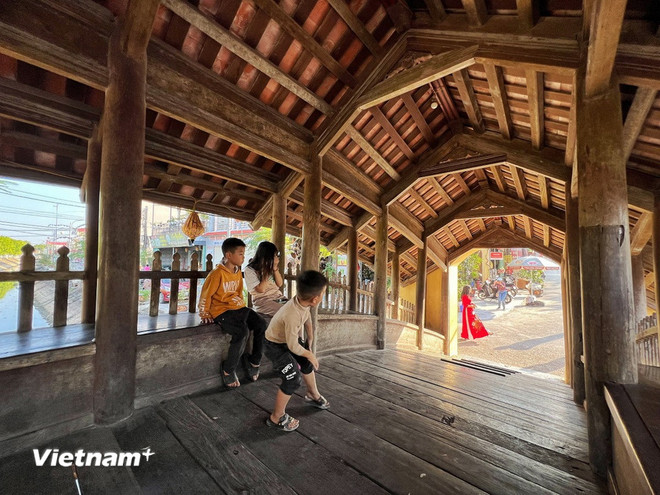
In the context of rapid urbanization, the ancient bridge still stands there, reminding people of their roots. Over the years, the local government and people have joined hands to preserve and restore the tiled bridge, keeping the ancient architecture intact. The locality also built a 5m wide stone bridge nearby for vehicles to pass through, reducing the load on the tiled bridge.
Thanks to that, the ancient tile-roofed bridge, which is over 500 years old, still retains its pristine appearance, becoming a unique cultural- tourist destination, where visitors can both admire an architectural masterpiece and feel the simple life of a Northern village./.
Source: https://www.vietnamplus.vn/chiem-nguong-cau-cho-luong-1-trong-3-cay-cau-ngoi-co-xua-va-dep-nhat-viet-nam-post1062667.vnp


![[Photo] Hanoi morning of October 1: Prolonged flooding, people wade to work](https://vphoto.vietnam.vn/thumb/1200x675/vietnam/resource/IMAGE/2025/10/1/189be28938e3493fa26b2938efa2059e)
















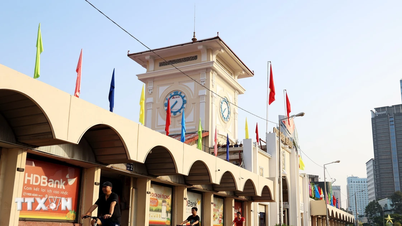




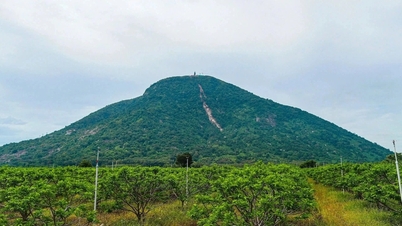

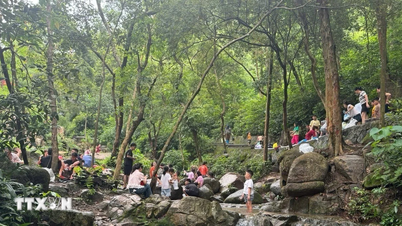





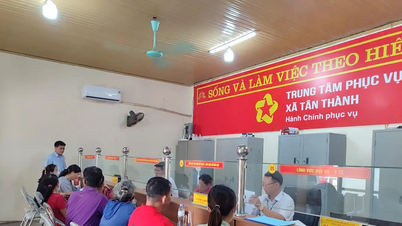





![[Photo] Panorama of the cable-stayed bridge, the final bottleneck of the Ben Luc-Long Thanh expressway](https://vphoto.vietnam.vn/thumb/1200x675/vietnam/resource/IMAGE/2025/9/30/391fdf21025541d6b2f092e49a17243f)






















































Comment (0)